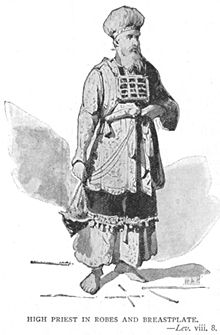- Priestly turban
-
Part of Judaic series of articles on Priesthood in Judaism 
Kohen · Recognition of priestly descent
Priestly covenantRolesPriestly blessing · Redemption of the firstborn son
Tzaraath (skin disease and mildew)
The Torah instruction of the Kohanim
Sacrifice · Incense offering
Beth din shel KohanimAaron · Eleazar · Phinehas
· Eli · Ahimelech · Abiathar
(First Temple)
· Zadok · Shallum · Hilkiah · Jehoiada
(Second Temple)
Joshua the High Priest
Simeon the Just
Elazar Ben Charsum
Yishmael Ben Elisha
Yehoshua ben Gamla
Pinchus Ben ShmuelTwenty-four priestly giftsThe ten gifts given in the Temple
1. Sin offering · 2. Guilt offering
3. Communal peace offering
4. Fowl sin offering · 5. Leftovers from the suspensive guilt offering
6. Oil from the offering for the leper
7. Bread from First Fruits · 8. Showbread
9. Leftovers of the meal offering
10. Leftovers of the First Sheaf.
Ten gifts given (even) outside of Jerusalem
Four gifts given in Jerusalem
11. Firstborn animal · 12. Firstfruits
13. Burnt offering (Judaism) ·
14. Parts of the thank offering and Nazirite's offering
15. Heave offering
16. Heave offering of the Levite's tithe
17. Dough offering
18. First shearing of the sheep
19. Shoulder, cheeks and maw
20. Coins for redemption of the first born son · 21. Redemption of a donkey
· 22. Dedication of property to a priest
· 23. Field not redeemed in a Jubilee year · 24. The property of the foreigner with no heir.ClothingPriestly garments
Priestly undergarments
Priestly tunic
Priestly turban · Priestly robe (Judaism)
Ephod · Priestly breastplate · Priestly frontlet
Urim and Thummim
Priestly sashMiscellaneous topicsThe Mitzvah of sanctifying the Kohen
Kohanic disqualifications
Holy anointing oil
Aaron's rod
Bat-Kohen (daughter of a kohen)
Sons of Zadok
Contact by a kohen with a dead bodyFor the helmet cover, see Mitznefet (Israeli military). The High Priest in his Golden Garments wearing the mitre on his head. The priest on one knee beside him is wearing the conical migbahat.
The High Priest in his Golden Garments wearing the mitre on his head. The priest on one knee beside him is wearing the conical migbahat.
The priestly mitre or turban (Hebrew mitznefet מִצְנֶפֶת) was the head covering worn by the Jewish High Priest when he served in the Tabernacle and the Temple in Jerusalem.[1][2]
Contents
Etymology
The Hebrew word mitznefet (מִצְנֶפֶת) has been translated as "mitre" (KJV) or "headdress". It was most likely a "turban", as the word comes from the root "to wrap".
Hebrew Bible
The turban worn by the High Priest was much larger than the head coverings of the priests and wound so that it formed a broad, flat-topped turban, resembling the blossom of a flower. The head covering of the priests was different, being wound so that it formed a cone-shaped turban, called a migbahat.
The priestly crown (Hebrew tzitz צִיץ "blossom" "flower") was attached to the turban by means of two sets of blue cords: one going over the top of the head and the other around the sides of the head at the level of the ears (Exodus 39:31).
Talmud
According to the Talmud, the wearing of the turban atoned for the sin of haughtiness on the part of the Children of Israel (B. Zevachim 88b).
References
- ^ Jacob Neusner Yoma Page 16 "And he placed the breastpiece on him, and in the breastpiece he put the Urim and the Thummim. And he set the turban ... Then Moses took the anointing oil, and anointed the tabernacle and all that was in it, and consecrated them.
- ^ Chaim Miller The Gutnick Edition Chumash Book of Exodus: With Rashi's Commentary 2005 Page 285 "(It was thus ready) for service (in the Tabernacle) as God had commanded Moshe. 27 They made the checkered Tunic from linen through a professional weaver, for Aharon and for his sons, 28 the linen Turban (for Aharon),..."
See also
- Priestly undergarments
- Priestly tunic
- Priestly sash
- Priestly robe (Judaism)
- Ephod
- Priestly breastplate
- Priestly frontlet
Categories:- Tabernacle and Jerusalem Temples
- Jewish religious clothing
Wikimedia Foundation. 2010.

